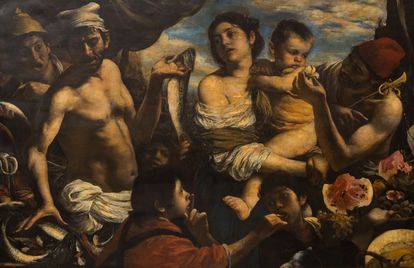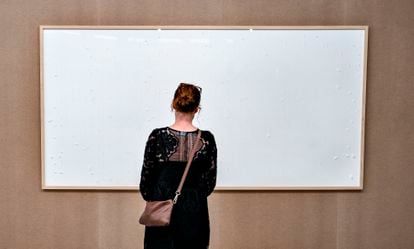Who knew that it would be enough to artificially age a contemporary painting to multiply its price by more than 100? Of course, such a scam has to be done conscientiously, with a certain method and a high degree of impudence.
The fraud in question took place on November 21, 2023, at Deutsch Auctioneers, a Viennese auction house. The scandal has just come to light, thanks to an article by Simone Facchinetti in Il Giornale dell’Arte. It was enough — in the words of Facchinetti — for a layer of “cunning makeup” over a rather trivial canvas by the Neapolitan painter Donato Grieco (born in 1939) for it to be convincingly attributed to the Baroque master Pacecco De Rosa (1607-1656).
The estimated price of the piece — which ranged between 900 and 1,800 euros ($980 and $1,960) — was already somewhat suspicious. As Facchinetti indicates, “who would be willing to part with an (alleged) masterpiece by an established painter at a bargain price?” Some of its potential buyers assumed that it was the work of an imitator, or someone worthy of De Rosa’s workshop, but they still bid for it. Nobody questioned its age and the possibility of its value continuing to appreciate in the medium-term.

In the end, Scena di Mercatto (in Englush: A market scene) — which is the title of the 45 x 70 inch painting — received several offers and was sold for a final amount of 72,000 euros, or $78,000. The anonymous collector who acquired the piece did so, apparently, without even having the opportunity to see it in person; they were guided exclusively by the images displayed online by the auction house. These same images allowed an anonymous fan to verify that it was the same piece that had been sold two months earlier, on July 17, for a mere 650 euros, or $710.
The transformation of an authentic (but low-value) Grieco into a false De Rosa was very simple. The author of the hoax limited himself to carefully erasing the two signatures (one was in the lower left margin of the painting and the other on the back), applying a layer of yellowish varnish and making a series of small surgical points of damage that ended up giving the fabric an aged look. In this specific case, the buyer may return the work and demand a refund, given that it has been proven that the attribution of authorship wasn’t only erroneous, but also fraudulent.
In the opinion of gallery owner and art curator Llucià Homs, “the business of buying and selling art has barely evolved in the last century-and-a-half, but the emergence of virtual auctions and NFTs — the varieties of digital art associated with the rise of cryptocurrencies — have completely transformed the rules of the game.” For Homs, “the valuation criteria that served as a compass in the sector have been disrupted and diluted” by the emergence of “a generation of young collectors and speculative investors with a lot of money and, often, [limited] judgment.” This new buyer profile is “artificially inflating [prices at] online auctions, which have almost become like television shows.”
Beatriz Ordovás — director of Contemporary Art at Christie’s, one of the main auction houses in the world — shares, with nuances, Homs’ opinion. From her point of view, “a sifting” should already be taking place and “quality criteria” should be recovering, but the market still hasn’t finished processing the impact of that speculative spring of crypto art, back in 2021. During that period, a collage of 5,000 images in NFT format — the work of an American artist named Beeple (Mike Winkelmann) — “sold for more than $69 million, a scandalous amount, completely [beyond the scope] of the market. That can only be attributed to a speculative bubble, which has now subsided to a large extent, but has left a deep mark.”

Take the money and run
Compared to the systemic convulsions that the art market has suffered from in recent years, the De Rosa fraud could be interpreted as a minor collateral effect of an influx of fresh money and a loss — temporary or not — of good judgment. Despite everything, it’s refreshing to note that, in the era of Beeple, there’s still room for artisanal picaresque in the art business, as various shameless actions — halfway between conceptual transgressions and crude scams — have revealed.
One such case is that of the “immaterial” sculpture that the Italian artist Salvatore Garau sold for $15,000 in 2021. For his detractors, it’s white-collar theft, given that Garau didn’t sell a concept or a sketch, but rather sold a supposedly finished work that cannot be seen or felt… because it doesn’t even exist. That is to say, he put a price on “nothing,” taking minimalism and conceptual art to the most fraudulent and deranged extreme.
For art critic Eli Federman, this is the equivalent of unscrupulous people trying to sell their souls on eBay: “Even if it’s a free transaction between adults, if they buy your soul and you don’t send it, they can sue you for breach of contract.” And suing Garau is precisely what another artist — the American Tom Miller — did. Although the reason for the legal action is that Miller demands that he be recognized as the person who came up with immaterial sculptures. He argues that he was the first to develop the concept and (not) put it into practice.
Even more baffling is the case of the Danish artist Jens Haaning, famous for his conceptual creations with political content. The Kunsten Museum of Modern Art in Aalborg (Denmark) sent him an advance of 84,000 euros ($91,000) to update one of his most famous performative works: a tablet showing enlargements of two bank statements, that of an average Dane and that of an immigrant in Denmark. Haaning took his time, exhausted all the agreed-upon deadlines, and ended up sending the museum two empty frames in which he had written a title: Take the Money and Run.

As the artist explained, the work — as he conceived it — had been completed: “It simply consisted of keeping the money.” He invited the institution to display the empty frames, contextualize them and let the public draw their own conclusions.
Lasse Andersson — director of the museum — wasn’t at all satisfied with the proposed solution. He’s still demanding that Haaning return the advance, given that the planned work was never delivered. However, he thinks that the artist should be allowed to keep an amount (940 euros, just over $1,000) as reasonable remuneration for his creative efforts.
Finally, Zachary Small reports in The New York Times the elaborate hoax that the young New York-based artist Zachary Ginsberg has been subjected to. After years of exhibiting his work through his website and Instagram page (making few sales in the process) Ginsberg received an online offer from a supposed collector for $3,400. The buyer offered to send him a check and include an extra amount for shipping costs, since the work had to be sent to its destination through an intermediary, a certain Lisa Shady, with a postal address in Fond du Lac, Wisconsin. Ginsberg sent Shady the $2,000 that, in theory, it was going to cost to transport the piece. But as soon as he attempted to cash the buyer’s check, it bounced.
Fond du Lac, by the way, is the town of 46,000 people where Beeple (Mike Winkelmann) was born 42 years ago. Nobody can say that scammers don’t have a sense of humor.
Sign up for our weekly newsletter to get more English-language news coverage from EL PAÍS USA Edition
This post was originally published on this site be sure to check out more of their content







